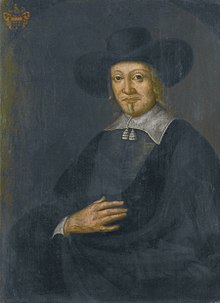Carel Reyniersz
Carel Reyniersz (* 1604 in Amsterdam ; † 19 May 1653 in Batavia ) was Governor General of the Dutch East Indies from 1650 to 1653 . His successor was Joan Maetsuycker .
Live and act
Carel Reyniersz was born in 1604 (according to a source 1602) to the Amsterdam merchant Dirck Reyniersz and his second wife, Suzanna de Beaulieu from Antwerp . His baptism took place on August 26, 1604. He worked as a trader and moved to the Coromandel Coast around 1628 . When the governor of the local province Marten IJsbrantsz went to Batavia in 1935, Reyniersz succeeded him. At the same time he temporarily became an extraordinary (mainly advisory) member of the Raad van Indië (Council of India), the central organ of the Dutch colonial administration in Asia. In 1638 he became a full member of the council. The following year he returned to the Netherlands as a fleet commander.
In 1640 he married Judith Barra, the 23-year-old daughter of the doctor Jacobus Barra from Antwerp, in Amsterdam. The marriage had a daughter, Sara, who died early.
In unsuccessful speculative transactions, Reyniersz lost all of his fortune. He then took up his position on the council again in 1645 and took the ship de Salamander back to India. A few days after their arrival in Batavia on July 21, 1646, his wife died. In the same year Reyniersz was next to his council position also chairman of the local aldermen .
In May 1648 he married fourteen-year-old Françoise de Wit in Batavia (born January 6, 1634 in Masulipatam , India; † January 10, 1672). She was the daughter of the merchant Jacob de Witt and Suzanna Wateringhe from Schiedam , Dutch immigrants living in India. The couple had a son, Reynier Carelsz Reyniersz, who did not live long either.
After the incumbent Governor General of the Dutch East Indies, Cornelis van der Lijn, resigned at his own request, Reyniersz was appointed his successor on October 6, 1650. Reyniersz's tasks included securing the Netherlands' supremacy on the spice market and taking action against private spice trade and overproduction. Among other things, he made an agreement with the King of Ternate on the entire stock of clove trees in his kingdom. Reyniersz also campaigned for the spread of the Christian religion , had Moorish and Chinese temples closed and urged the priests to convert. During his term of office the founding of the Dutch colony at the Cape of Good Hope in 1652 and the beginning of the fight with the Portuguese on Ceylon in the same year.
When Reyniersz fell ill, he applied for his resignation, thus preventing a dismissal because the Heeren XVII were dissatisfied with his reign. From February 25, 1653 Joan Maetsuycker took over the duties of Governor General.
By the time Heeren XVII's notice of dismissal arrived in Batavia in 1654, Reyniersz had already died. He died on the night of May 18-19, 1653 in Batavia and was buried with his first wife in the Dutch Kreuzkirche ( Kruiskerk ) in Batavia. His widow remarried, had a son and returned to the Netherlands in 1656.
literature
- Johannes François Snelleman (Ed.): Encyclopædie van Nederlandsch-Indië. Deel 3: Naaktslakken - Soekapoera. Nijhoff et al., 'S-Gravenhage et al. 1902.
- LP van Putten: Ambitie en onvermogen. Volume 1: Gouverneurs-generaal van Nederlands-Indië 1610–1796. ILCO-Productions, Rotterdam 2002, ISBN 90-6734-021-9 .
- FW pile: REYNIERSZ (Carel) . In: Petrus Johannes Blok , Philipp Christiaan Molhuysen (Ed.): Nieuw Nederlandsch Biografisch Woordenboek . Part 7. N. Israel, Amsterdam 1974, Sp. 1045-1046 (Dutch, knaw.nl / dbnl.org - first edition: AW Sijthoff, Leiden 1927, reprinted unchanged).
- Abraham Jacob van der Aa : REINIERSZ (Karel) In: Biographical woordenboek der Nederlanden. Deel 16. Haarlem, 1874, pp. 202-203 ( online ).
Individual evidence
- ↑ Abraham Jacob van der Aa: REINIERSZ (Karel) In: Biographisch woordenboek der Nederlanden. Deel 16. Haarlem, 1874, p. 202.
- ↑ FW pile: REYNIERSZ (Carel). In: Nieuw Nederlandsch Biografisch Woordenboek, Deel 7. Edited by Petrus Johannes Blok and Philipp Christiaan Molhuysen, Leiden 1927, p. 1045.
- ^ Jean Gelman Taylor: The social world of Batavia: European and Eurasian in Dutch Asia. University of Wisconsin Press, London 1983, ISBN 02-99094-70-7 , p. 35.
- ↑ a b F.W. Stack: REYNIERSZ (Carel). In: Nieuw Nederlandsch Biografisch Woordenboek, Deel 7. Edited by Petrus Johannes Blok and Philipp Christiaan Molhuysen, Leiden 1927, p. 1046.
- ↑ Abraham Jacob van der Aa: REINIERSZ (Karel) In: Biographisch woordenboek der Nederlanden. Deel 16. Haarlem, 1874, p. 203.
| personal data | |
|---|---|
| SURNAME | Reyniersz, Carel |
| ALTERNATIVE NAMES | Reniers, Carel; Reiniersz, Karel |
| BRIEF DESCRIPTION | Governor General of the Dutch East Indies |
| DATE OF BIRTH | 1604 |
| PLACE OF BIRTH | Amsterdam |
| DATE OF DEATH | May 19, 1653 |
| Place of death | Batavia |

